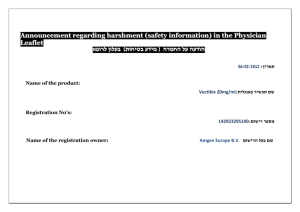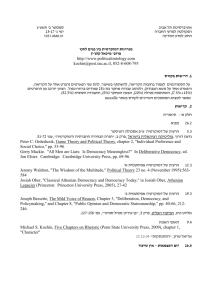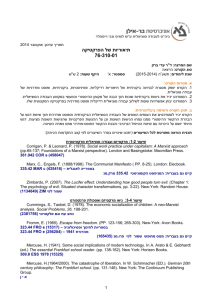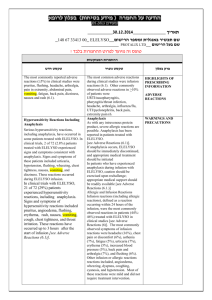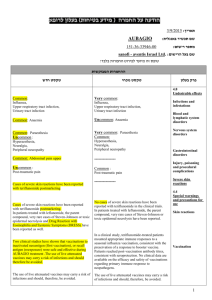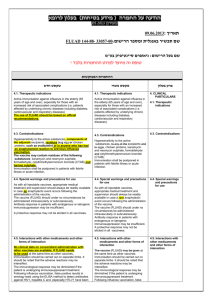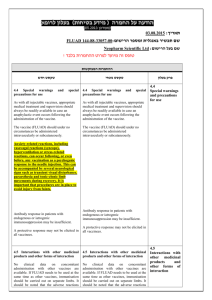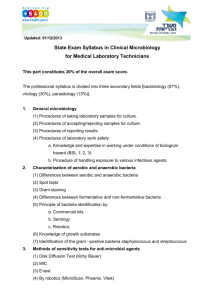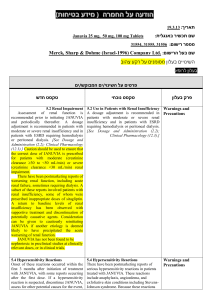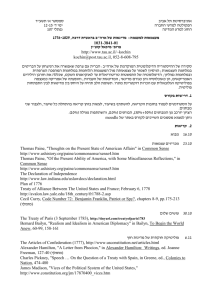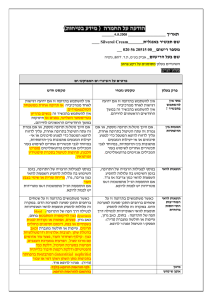שם הקורס: ביוכימיה לכימאים ב` Biochemistry for chemists (B)
advertisement
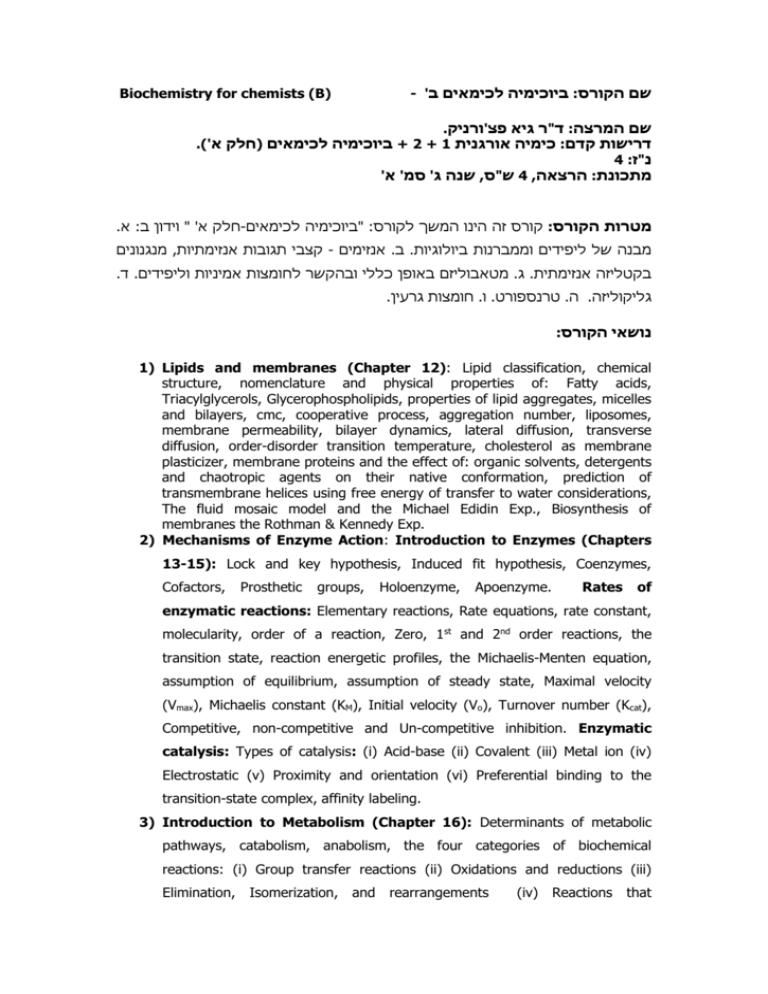
Biochemistry for chemists (B) - ' ביוכימיה לכימאים ב:שם הקורס . ד"ר גיא פצ'ורניק:שם המרצה .)' ביוכימיה לכימאים (חלק א+ 2 + 1 כימיה אורגנית:דרישות קדם 4 :נ"ז ' שנה ג' סמ' א, ש"ס4 , הרצאה:מתכונת . א:חלק א' " וידון ב- "ביוכימיה לכימאים: קורס זה הינו המשך לקורס:מטרות הקורס מנגנונים, קצבי תגובות אנזימתיות- אנזימים. ב.מבנה של ליפידים וממברנות ביולוגיות . ד. מטאבוליזם באופן כללי ובהקשר לחומצות אמיניות וליפידים. ג.בקטליזה אנזימתית . חומצות גרעין. ו. טרנספורט. ה.גליקוליזה :נושאי הקורס 1) Lipids and membranes (Chapter 12): Lipid classification, chemical structure, nomenclature and physical properties of: Fatty acids, Triacylglycerols, Glycerophospholipids, properties of lipid aggregates, micelles and bilayers, cmc, cooperative process, aggregation number, liposomes, membrane permeability, bilayer dynamics, lateral diffusion, transverse diffusion, order-disorder transition temperature, cholesterol as membrane plasticizer, membrane proteins and the effect of: organic solvents, detergents and chaotropic agents on their native conformation, prediction of transmembrane helices using free energy of transfer to water considerations, The fluid mosaic model and the Michael Edidin Exp., Biosynthesis of membranes the Rothman & Kennedy Exp. 2) Mechanisms of Enzyme Action: Introduction to Enzymes (Chapters 13-15): Lock and key hypothesis, Induced fit hypothesis, Coenzymes, Cofactors, Prosthetic groups, Holoenzyme, Apoenzyme. Rates of enzymatic reactions: Elementary reactions, Rate equations, rate constant, molecularity, order of a reaction, Zero, 1st and 2nd order reactions, the transition state, reaction energetic profiles, the Michaelis-Menten equation, assumption of equilibrium, assumption of steady state, Maximal velocity (Vmax), Michaelis constant (KM), Initial velocity (Vo), Turnover number (Kcat), Competitive, non-competitive and Un-competitive inhibition. Enzymatic catalysis: Types of catalysis: (i) Acid-base (ii) Covalent (iii) Metal ion (iv) Electrostatic (v) Proximity and orientation (vi) Preferential binding to the transition-state complex, affinity labeling. 3) Introduction to Metabolism (Chapter 16): Determinants of metabolic pathways, catabolism, anabolism, the four categories of biochemical reactions: (i) Group transfer reactions (ii) Oxidations and reductions (iii) Elimination, Isomerization, and rearrangements (iv) Reactions that make\brake C-C bonds, Carbanion stabilization via: (a) Hydrogen bonds (b) formation of Schiff-base (c) Multivalent metals, Thermodynamics of phosphate compounds, phosphate group transfer potential, chemical and energetic considerations of the phsophoanhydride bonds of ATP, Substrate level and Oxidative phosphorylation, Redox potential, Electron transport pathway, Cofactors and coenzymes. 4) Glycolysis (Chapter 17): The ten enzymatic reactions which transform glucose into pyruvate and ATP will be presented in great detail. Reaction mechanisms, energetic considerations and the rationale exhibited by this sequence of reactions will be discussed. 5) Transport through membranes (Chapter 20): Thermodynamics of transport, Chemical and electrical potential difference, membrane potential, Kinetics and mechanism of transport (Simple diffusion, Passive transport, Active transport, Permeability coefficient and Partition coefficient, Features of mediated transport (Speed and specificity, Saturation kinetics, Susceptibility to competitive inhibition and chemical inactivation, ATP-driven transport (Uniport, Symport and antiport). 6) Lipid metabolism(Chapter 25). Catalytic hydrolysis of triglycerides via the oxyanion tetrahedral intermediate, fatty acid oxidation, the β-oxidation mechanism, the thiolase reaction using a Claisen ester cleavage. 7) Amino acid metabolism (Chapter 26): Deamination, Transamination, Tautomerization, Oxidative deamination, the Urea cycle. 8) Nucleic acids (Chapter 5): Chemical structure of DNA and RNA, Thermodynamic consideration associated with double stranded DNA, susceptibility of RNA to based-catalyzed hydrolysis, the Tetranucleotide hypothesis, The discovery of the transforming principle (Griffith, Avery, McCarty and Macleod), the Hershey-Chase Exp., Erwin Chargaff’s rule, The discovery of the double helix by Watson and Crick, Semi-conservative replication (Meselson and Stahl Exp. utilizing equilibrium density gradient ultracentrifugation), synthesis of polynucleotides. נוכחות חובה:דרישותהקורס . מבחן011%:הערכת הסטודנט בקורס :ביבליוגרפיה - Donald Voet and Judith G. Voet, Biochemistry, 4th Edition, John Wiley.
